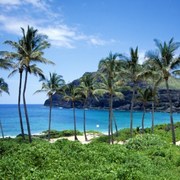 Brand X Pictures/Thinkstock
Brand X Pictures/Thinkstock
In my recent visit to Hawaii, I made a stop at the local kava bar. I wanted to brush up on my kava herb knowledge and to see what the kava hubbub was all about.
For centuries, Hawaiians and the Pacific Islanders have used kava as part of their ceremonial rituals. Even today, my Hawaiian ʺbruhhdahsʺ regularly enjoy drinking kava.
Kava, which is a plant with deep roots, is native to the Hawaiian and South Pacific Islands. Kava is also known as awa, kava pepper, kava kava or piper methysticum.
The underground stem and root of the kava plant is smashed and mixed with water. After the mixture is strained, it is generally served at room temperature and in a coconut shell.
Kava bars are popular in Hawaii. Most of the main towns have a kava spot which is frequented by locals and international travels. On my visit, there were Hawaiian locals or kama'āina’s and travelers from Germany, Japan and Australia.
The cost of a shell will run you about 5 bucks. The taste of kava equals a bowl of milky, nutty, dirt water. The recommended use is 1-2 cups during your visit to a kava bar.
Everyone drinks their kava differently. Some will drink it straight and throw it back or chug it. Others, like myself, will nurse it and occasional stir it with a piece of pineapple. Also, you can mix the kava with coconut milk or an exotic fruit juice like guava, mango, or pineapple.
After you drink kava, you will notice that your tongue may become numb. This is short-lived and only lasts about 30-45 minutes. Kava can also be used as a numbing topical agent. Kava is a diuretic, so expect to make a few potty stops.
Kava is all natural and many drink kava to relax after a hard stressful day. Personally, I’d rather drink something natural than pop a pill or have a glass of wine. Kava can also be purchased in a capsule form at a health food store. There is also kava tea which you can prepare with hot water.
Natural herbal products are prevalent in the Hawaiian culture, as well as other cultures. According to the University of Maryland Medical Center (UMM) nearly one-third of Americans use herbs, and the World Health Organization stated that more than ʺ80 percent of people worldwide rely on herbal medicines for some part of their primary health care.ʺ
Kava has been used in the following ways:
• Treat asthma
• Treat urinary tract infections
• Treat insomnia
• Treat anxiety
• Treat menopausal symptoms
Now, some words of caution about kava. According to the National Center of Complementary and Alternative Medicine (NCCAM):
• Avoid driving and operating heavy machinery while taking kava because the herb has been reported to cause drowsiness.
• Kava has been reported to cause liver damage.
• Long-term and/or heavy use of kava may result in scaly, yellowed skin.
• Kava has been associated with several cases of dystonia (abnormal muscle spasm or involuntary muscle movements). Kava may interact with several drugs, including drugs used for Parkinson’s disease.
If you are on certain medications such statins or other medications, it is a good idea to check with your doctor before you indulge. According to Dr. Ray Sahelian, Kava is not the type of supplement to take everyday and it is advised that you not use the herb more than two times a week.
So, if you visit the islands, stop by your local kava bar for a cup of relaxation and enjoy your surroundings.
As one kama'āina told me at the local kava bar, ʺno one has ever robbed a bank after drinking kava.ʺ
References:
FeedBurner. Find an Herbalist | American Herbalists Guild. American Herbalists Guild | An Association of Herbal Practitioners. Retrieved March 22, 2012, from http://www.americanherbalistsguild.com/fundamentals
Hawaiian Kava Center: About kava. Hawaiian Kava Center: Aloha. Retrieved March 22, 2012, from
http://hawaiiankava.com/about.html
Herbal medicine. University of Maryland Medical Center | Home. Retrieved March 22, 2012, from
http://www.umm.edu/altmed/articles/herbal-medicine-000351.htm#ixzz1jqMAqxQO
Kava: Science and Safety | NCCAM. Home Page | NCCAM. Retrieved March 22, 2012, from
http://nccam.nih.gov/health/kava
Kava for stress, anxiety, dosage, side effects, benefits, risks, danger, liver by Ray Sahelian, M.D.. Ray Sahelian, M.D., nutrition expert and best selling author. Retrieved March 22, 2012, from
http://www.raysahelian.com/kava.html
KavaRoot - What Is Kava? Kava Root.com. Retrieved March 22, 2012, from http://kavaroot.com/aboutkava_frames.htm
Lebot, V., Merlin, M., & Lindstrom, L. Kava--the Pacific elixir: the definitive guide to its ethnobotany, history ... - Vincent Lebot, Mark Merlin, Lamont Lindstrom - Google Books. Google Books. Retrieved March 22, 2012, from http://books.google.com/books?id=wxTrQOP36NsC&pg=PA256&lpg=PA256&dq=Kava:+The+Pacific+Elixir+by+Vincent+Lebot,+Ph.D.&source=bl&ots=Gf0krS4xN9&sig=-a0RciaYGtgZPzHS4q-OaagxKVc&hl=en&sa=X&ei=WB1pT-egBoqgiQLWxvTcBg&sqi=2&ved=0CD8Q6AEwAg#v=onepage&q&f=false
Reviewed March 22, 2012
by Michele Blacksberg RN
Edited by Jody Smith




Add a CommentComments
There are no comments yet. Be the first one and get the conversation started!